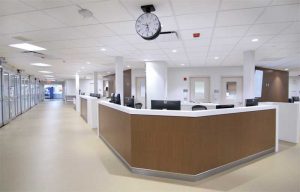by Mark Huxta and Sharon Paley

According to the research paper, “Shades of Florence Nightingale: Potential Impact of Noise Stress on Wound Healing,” “Noise has long been recognized as an environmental stressor that causes physiological, psychological, and behavioral changes in healthy subjects. Environmental noise and its potential effects on healing and recovery are of special concern to nurses in hospital settings, where increased levels of noise and the effect of noise on patient sleep and cognitive function have been well documented in the literature,” (the paper was written by D.O. McCarthy, M.E. Ouimet, and J.M. Daun for the Holistic Nurse Practice in 1991).
Perhaps one of the most significant examples left behind by the founder of modern nursing, Florence Nightingale, was her commitment to patient care. She understood the importance of producing a state of mind and body conducive to healing. When it comes to designing the built environment in a way that promotes healing, the old adage of “out of sight, out of mind” rings true, as acoustics are too often neglected. Yet, according to the 2018 Hospital Consumer Assessment of Healthcare Providers and Systems (HCAHPS) scores, noise remains one of the poorest scoring categories.
The World Health Organization (WHO) guidelines call for continuous background noise in hospital patient rooms to remain at or below 35 dB(A) during the day and 30 dB(A) at night, with nighttime peaks no higher than 40 dB(A) (for more information, consult the WHO’s guidelines for community noise). The dBA metric is the most commonly used one for noise control guidelines and regulations. It stands for A-weighted sound pressure levels. A-weighting is used to represent the human ear’s sensitivity to various sounds. A 2005 study examining U.S. hospital noise levels over the previous 45 years found no facility complied with these guidelines. In fact, hospital background noise levels have been increasing since the 1960s, up from 57 dB(A) in 1960 to 72 dB(A) in 2007 during the daytime, and 42 dB(A) in 1960 to 60 dB(A) during the night (refer to “Noise levels in Johns Hopkins Hospital” by Ilene J. Busch-Vishniaca, James E. West, Colin Barnhill, Tyrone Hunter, Douglas Orellana, and Ram Chivukula).

To better improve the healing environment for patients and providers, healthcare design professionals are now seeking materials with specific acoustic benefits. While noise is a subjective term and can be traced to a variety of sources (e.g. hallway conversations, footsteps, rolling carts, and alarms), hospitals and healthcare facilities are working to implement sound control and mitigate sound transmission, as both play a key role in creating a healing space.
Impact of noise on patients and staff
A comfortable acoustic environment is vital to supporting the safety, health, healing, and well-being of patients and providers. Patients’ physiological health can be negatively affected by poor acoustics, inhibiting the healing process and increasing their chances for readmission. High noise levels can lead to patient annoyance, sleep disruption, elevated blood pressure, and decreased healing rates (read “Influence of intensive coronary care acoustics on the quality of care and physiological state of patients” by I. Hagerman, G. Rasmanis, V. Blomkvist, R. Ulrich, C.A. Eriksen, and T. Theorell). In terms of mental and emotional health, acoustics can impact how comfortable and secure a patient and their family members feel in the healthcare setting. Noise is of particular concern in behavioral health facilities where there is a strong emphasis on creating a calm, quiet environment for patients. Loud noises that startle patients or disrupt sleep can have long-term effects, while poor sound isolation can present a lack of privacy and also cause discomfort.
Similarly, patient care teams also feel the impact of poor acoustics. When completing tasks in a space with a high level of noise, providers may have to exert more energy to listen or be heard, which can cause fatigue and burnout. Speech intelligibility is imperative in a healthcare environment, and extraneous sounds can impede providers’ abilities to understand and quickly respond to a variety of auditory signals, such as conversations, alarms, and other equipment, which directly affect patient care and human error.
Further, the Health Insurance Portability and Accountability Act (HIPAA) requires individual patient information that is communicated orally, written, or digitally must remain private. When the healthcare environment is finished with sound-reflecting materials or designed without acoustics in mind, discussions among patients and providers can easily carry into other areas and be overheard by an unintended listener. Poor acoustic design increases the risk of noncompliance with federal privacy regulations.




